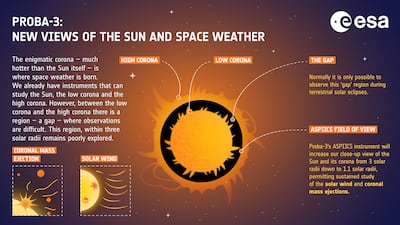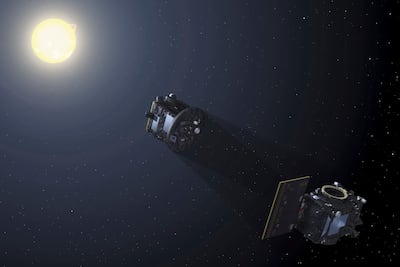Scientists can take a longer, clearer look at the Sun’s outer atmosphere thanks to a European mission that created the first artificial solar eclipse in space.
The feat was made possible by the European Space Agency’s Proba-3 mission, which involved two spacecraft flying in perfect formation more than 600km above Earth.
The pair lined up to block out the bright disc of the Sun and reveal its faint outer atmosphere, called the corona, creating an artificial eclipse. Striking composite images were released on Monday by the space agency.
Dr Dimitra Atri, principal investigator at the New York University Abu Dhabi’s Space Exploration Laboratory, said the achievement amounted to a breakthrough in solar science.
“It will help us tackle one of the field's biggest puzzles: why the Sun's corona burns hundreds of times hotter than its surface,” Dr Atri, was not involved in the research, told The National.
He said researchers would now be able to study the corona for hours at a time by creating the much longer artificial solar eclipses.
“This gives us an opportunity to study the turbulent processes that fuel space weather,” he said.
The surface of the Sun reaches about 5,500°C, while the corona can reach more than a million degrees.
Current theories suggest the extreme heat could be caused by the Sun’s magnetic fields and waves of charged particles, but this could be challenged with Proba-3's feat.
To make the eclipse appear, the two satellites flew in a carefully controlled formation, maintaining a fixed distance of 144 metres while orbiting Earth.
One satellite blocked the Sun’s light while the other captured images of the exposed corona. This required millimetre-level precision to align perfectly, said the European Space Agency.
Studying the Sun’s secrets
During a natural eclipse, scientists have only a few minutes to view and photograph the corona.
This region is where violent solar activity originates, including flares and coronal mass ejections that can damage satellites, disrupt navigation systems and cause power cuts on Earth.
“The mission will dramatically improve our ability to forecast solar storms that threaten satellites and electrical grids, while deepening our knowledge of how stars function across the universe,” said Dr Atri.
“The engineering feat of keeping two spacecraft flying in precise formation also opens new doors for future more complex missions.”
Six-hour eclipse
Andrei Zhukov, from the Royal Observatory of Belgium, who was part of the research, said he was thrilled to see the images as they secured them in the first attempt.
“Our artificial eclipse images are comparable with those taken during a natural eclipse,” he said in a statement.
“The difference is that we can create our eclipse once every 19.6-hour orbit, while total solar eclipses only occur naturally around once, very rarely twice, a year.
“On top of that, natural total eclipses only last a few minutes, while Proba-3 can hold its artificial eclipse for up to six hours.”
RESULT
Leeds United 1 Manchester City 1
Leeds: Rodrigo (59')
Man City: Sterling (17')
Man of the Match: Rodrigo Moreno (Leeds)
Itcan profile
Founders: Mansour Althani and Abdullah Althani
Based: Business Bay, with offices in Saudi Arabia, Egypt and India
Sector: Technology, digital marketing and e-commerce
Size: 70 employees
Revenue: On track to make Dh100 million in revenue this year since its 2015 launch
Funding: Self-funded to date
UAE currency: the story behind the money in your pockets
How it works
Booklava works on a subscription model. On signing up you receive a free book as part of a 30-day-trial period, after which you pay US$9.99 (Dh36.70) per month to gain access to a library of books and discounts of up to 30 per cent on selected titles. You can cancel your subscription at any time. For more details go to www.booklava.com
MATCH INFO
Manchester United 2
(Martial 30', McTominay 90 6')
Manchester City 0
Results
5pm Maiden (PA) Dh80,000 1,400m
Winner No Riesgo Al Maury, Szczepan Mazur (jockey), Ibrahim Al Hadhrami (trainer)
5.30pm Handicap (PA) Dh80,000 1,600m
Winner Marwa W’Rsan, Sam Hitchcott, Jaci Wickham.
6pm Handicap (PA) Dh80,000 1,600m
Winner Dahess D’Arabie, Al Moatasem Al Balushi, Helal Al Alawi.
6.30pm Handicap (PA) Dh80,000 2,200m
Winner Safin Al Reef, Connor Beasley, Abdallah Al Hammadi.
7pm Wathba Stallions Cup Handicap (PA) Dh70,000 2,200m
Winner Thulbaseera Al Jasra, Shakir Al Balushi, Ibrahim Al Hadhrami.
7.30pm Maiden (TB) Dh 80,000 2,200m
Winner Autumn Pride, Szczepan Mazur, Helal Al Alawi.
RESULTS
Manchester United 2
Anthony Martial 30'
Scott McTominay 90 6'
Manchester City 0
MORE ON THE US DEMOCRATIC PRIMARIES
The biog
Hometown: Cairo
Age: 37
Favourite TV series: The Handmaid’s Tale, Black Mirror
Favourite anime series: Death Note, One Piece and Hellsing
Favourite book: Designing Brand Identity, Fifth Edition
Dates for the diary
To mark Bodytree’s 10th anniversary, the coming season will be filled with celebratory activities:
- September 21 Anyone interested in becoming a certified yoga instructor can sign up for a 250-hour course in Yoga Teacher Training with Jacquelene Sadek. It begins on September 21 and will take place over the course of six weekends.
- October 18 to 21 International yoga instructor, Yogi Nora, will be visiting Bodytree and offering classes.
- October 26 to November 4 International pilates instructor Courtney Miller will be on hand at the studio, offering classes.
- November 9 Bodytree is hosting a party to celebrate turning 10, and everyone is invited. Expect a day full of free classes on the grounds of the studio.
- December 11 Yogeswari, an advanced certified Jivamukti teacher, will be visiting the studio.
- February 2, 2018 Bodytree will host its 4th annual yoga market.
Results
Stage 4
1. Dylan Groenewegen (NED) Jumbo-Visma 04:16:13
2. Gaviria (COL) UAE Team Emirates
3. Pascal Ackermann (GER) Bora-Hansgrohe
4. Sam Bennett (IRL) Deceuninck-QuickStep
5. Caleb Ewan (AUS) Lotto Soudal
General Classification:
1. Adam Yates (GBR) Mitchelton-Scott 16:46:15
2. Tadej Pogacar (SLO) UAE Team Emirates 0:01:07
3. Alexey Lutsenko (KAZ) Astana Pro Team 0:01:35
4. David Gaudu (FRA) Groupama-FDJ 0:01:40
5. Rafal Majka (POL) Bora-Hansgrohe
MATCH INFO
France 3
Umtiti (8'), Griezmann (29' pen), Dembele (63')
Italy 1
Bonucci (36')
Who was Alfred Nobel?
The Nobel Prize was created by wealthy Swedish chemist and entrepreneur Alfred Nobel.
- In his will he dictated that the bulk of his estate should be used to fund "prizes to those who, during the preceding year, have conferred the greatest benefit to humankind".
- Nobel is best known as the inventor of dynamite, but also wrote poetry and drama and could speak Russian, French, English and German by the age of 17. The five original prize categories reflect the interests closest to his heart.
- Nobel died in 1896 but it took until 1901, following a legal battle over his will, before the first prizes were awarded.
Overview
Cricket World Cup League Two: Nepal, Oman, United States tri-series, Tribhuvan University, Kathmandu
Fixtures
Wednesday February 5, Oman v Nepal
Thursday, February 6, Oman v United States
Saturday, February 8, United States v Nepal
Sunday, February 9, Oman v Nepal
Tuesday, February 11, Oman v United States
Wednesday, February 12, United States v Nepal
Name: Brendalle Belaza
From: Crossing Rubber, Philippines
Arrived in the UAE: 2007
Favourite place in Abu Dhabi: NYUAD campus
Favourite photography style: Street photography
Favourite book: Harry Potter
French business
France has organised a delegation of leading businesses to travel to Syria. The group was led by French shipping giant CMA CGM, which struck a 30-year contract in May with the Syrian government to develop and run Latakia port. Also present were water and waste management company Suez, defence multinational Thales, and Ellipse Group, which is currently looking into rehabilitating Syrian hospitals.
At a glance - Zayed Sustainability Prize 2020
Launched: 2008
Categories: Health, energy, water, food, global high schools
Prize: Dh2.2 million (Dh360,000 for global high schools category)
Winners’ announcement: Monday, January 13
Impact in numbers
335 million people positively impacted by projects
430,000 jobs created
10 million people given access to clean and affordable drinking water
50 million homes powered by renewable energy
6.5 billion litres of water saved
26 million school children given solar lighting
COMPANY PROFILE
Name: Almnssa
Started: August 2020
Founder: Areej Selmi
Based: Gaza
Sectors: Internet, e-commerce
Investments: Grants/private funding
More on Quran memorisation:



